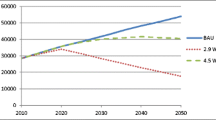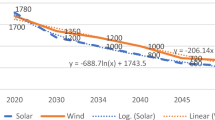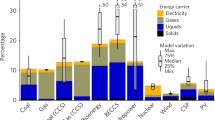Abstract
Energy system optimization models prescribe the optimal mix of technologies and fuels for meeting energy demands over a time horizon, subject to energy supplies, demands, and other constraints. There may be realistic reasons why solely relying on the least cost technological pathway is not practical, however. For example, difficult-to-quantify factors may complicate the rapid expansion of specific technologies. Modelers may choose to limit technology penetration with growth bounds. Whether growth bounds have been used and how these bounds impact the model outputs are not always transparent, however. In this work, alternative growth bounds on wind and solar power, nuclear power, and carbon dioxide (CO2) sequestration are examined for a hypothetical greenhouse gas (GHG) mitigation scenario. A nested parametric sensitivity analysis is used to examine the response to individual and combinations of bounds. From a modeling perspective, the results illustrate that growth bounds can have a large impact on shaping the least cost results. From a planning perspective, the results suggest that natural gas technologies may play a critical role in meeting GHG mitigation targets if optimistic goals for the expansion of nuclear, renewables, or sequestration are not met.
Access this chapter
Tax calculation will be finalised at checkout
Purchases are for personal use only
Similar content being viewed by others
Notes
- 1.
This target was not selected to represent any particular policy. Considering the potential role of domestic and international offsets, however, the magnitude of cumulative energy system CO2 reductions is similar to that of several policy options that have been discussed by Congress.
- 2.
The marginal price is the cost the model sees for one additional unit of a commodity. This is different than an average cost for the commodity, which effectively would be the average of the marginal prices of each unit X.
References
Barreto, L. (2001). Technological learning in energy optimization models and deployment of emerging technologies. (Unpublished doctoral dissertation), Swiss Federal Institute of Technology, Zurich, Switzerland.
Brown, S., Krupnick, A. J., & Walls, M. A. (2009). Natural gas: A bridge to a low-carbon future? (Issue brief 09–11). Washington, D.C.: Resources for the Future.
Electric Power Research Institute (EPRI). (2009). The power to reduce CO 2 emissions: The full portfolio (technical report). Palo Alto: Electric Power Research Institute.
Fishbone, L. G., & Abilock, H. (1981). MARKAL, a linear programming model for energy systems analysis: Technical description of the BNL version. Energy Research, 5, 353–375.
Goettle, R. J., Ho, M. S., Jorgenson, D. W., Slesnick, D. T., & Wilcoxen, P. J. (2007). IGEM, an inter-temporal general equilibrium model of the U.S. Economy with emphasis on growth, energy and the environment. (Report) Cambridge: Harvard University.
Häfele, W. (1981). Energy in a finite world. A global systems analysis. Cambridge: Ballinger Publishing Co.
Loulou, R., & Lavigne, D. (1995). MARKAL model with elastic demands: Application to greenhouse gas emission control. In C. Carraro, & A. Haurie (Eds.), Operations research and environmental management. Dordrecht: Kluwer Academic Publishers.
Lund, P. (2006). Market penetration rates of new energy technologies. Energy Policy, 34, 3317–3326.
Newell, R. (2009) Testimony before the committee on energy and natural resources of the United States Senate, 28 October.
Rogers, E. (1962). Diffusion of innovations. Glencoe: Free Press of Glencoe.
Ross, M. T. (2008). Documentation of the applied dynamic analysis of the global economy (ADAGE) model. Research Triangle Park: RTI International.
Saltelli, A., Chan, K., & Scott, E. M. (Eds.). (2000). Sensitivity analysis. New York: Wiley.
Silverberg, G. (1991). Adoption and diffusion of technology as a collective evolutionary process. Technology Forecasting and Social Change, 39, 67–80.
U.S. Congress (2009). American clean energy and Security Act of 2009. 111th U.S. Congress. 1st session. H.R. 2454. Read in U.S. Senate.
U.S. Department of Energy (U.S. DOE) (2008a). 20% wind energy by 2030: Increasing wind energy’s contribution to U.S. electricity supply. Office of Energy Efficiency and Renewable Energy.
U.S. Department of Energy (U.S. DOE) (2008b). Annual Energy Outlook 2008: With projections to 2030. Energy Information Administration (EIA), Office of Integrated Analysis and Forecasting. Washington, D.C.
U.S. Department of Energy (U.S. DOE) (2010). Annual energy outlook with projections to 2035. Energy Information Administration (EIA), Office of Integrated Analysis and Forecasting. Washington, D.C.
U.S. Environmental Protection Agency (U.S. EPA) (2006). Documentation for EPA Base Case 2006 (V.3.0) Using the Integrated Planning Model. Office of Air and Radiation. Washington, D.C.
U.S. Environmental Protection Agency (U.S. EPA) (2008). EPA U.S. nine region MARKAL database: (Draft) Database documentation. Research Triangle Park: Office of Research and Development.
U.S. Environmental Protection Agency (U.S. EPA) (2009a). 1970–2008 average annual emissions, all criteria pollutants. Office of Air Quality Planning and Standards.
U.S. Environmental Protection Agency (U.S. EPA) (2009b). EPA analysis of the American Clean Energy and Security Act of 2009: H.R. 2454 in the 111th Congress (Briefing Package). Washington D.C.: Office of Atmospheric Programs.
U.S. Environmental Protection Agency (U.S. EPA) (2010a). CFR Title 40 Part 60—standards of performance for new stationary sources. Title 40—protection of the environment. Code of Federal Regulations.
U.S. Environmental Protection Agency (U.S. EPA) (2010b). CFR Title 40 Part 86—control of Emissions from new and in-use highway vehicles and engines. Title 40—protection of the environment. Code of Federal Regulations.
U.S. Environmental Protection Agency (U.S. EPA) (2010c). CFR Title 40 Part 96—NO x budget trading programs and CAIR NO x and SO 2 trading programs for State Implementation Plans. Title 40: Protection of the environment. Code of Federal Regulations.
U.S. Environmental Protection Agency (U.S. EPA) (2010d). Hydraulic fracturing. http://water.epa.gov/type/groundwater/uic/class2/hydraulicfracturing/index.cfm. Retrieved in December, 2010.
U.S. Environmental Protection Agency (U.S. EPA) (2010e). Supplemental EPA analysis of the American Clean Energy and Security Act of 2009: H.R. 2454 in the 111th Congress (Briefing Package). Washington D.C.: Office of Atmospheric Programs.
Acknowledgments
The U.S. EPA National Model database, version 2.3, was used in this study. The author would like to acknowledge the contributions of many individuals to the MARKAL databases, including current and former members of the U.S. EPA Office of Research and Development’s Energy and Climate Assessment Team.
Disclaimer The views expressed in this presentation are those of the author and do not necessarily reflect the views or policies of the U.S. Environmental Protection Agency.
Author information
Authors and Affiliations
Corresponding author
Editor information
Editors and Affiliations
Rights and permissions
Copyright information
© 2013 Springer Science+Business Media Dordrecht
About this chapter
Cite this chapter
Loughlin, D. (2013). Exploring How Technology Growth Limits Impact Optimal Carbon dioxide Mitigation Pathways. In: Jawahir, I., Sikdar, S., Huang, Y. (eds) Treatise on Sustainability Science and Engineering. Springer, Dordrecht. https://doi.org/10.1007/978-94-007-6229-9_11
Download citation
DOI: https://doi.org/10.1007/978-94-007-6229-9_11
Published:
Publisher Name: Springer, Dordrecht
Print ISBN: 978-94-007-6228-2
Online ISBN: 978-94-007-6229-9
eBook Packages: Earth and Environmental ScienceEarth and Environmental Science (R0)




